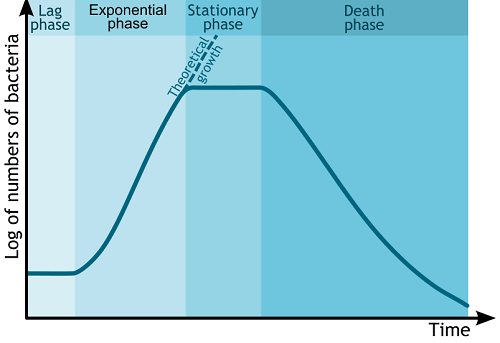Bacterial Growth CurveBacteria need certain circumstances for growth, which are not the same for every bacterium. The growth and development of bacteria are a combined effect of many factors. These factors are light, temperature, oxygen, and pH. These are the most important factors. Other factors required for development include atmospheric pressure, moisture, and osmotic pressure. The time of bacterial growth and reproduction varies from species to species. The time bacteria take to double themselves (reproduction) is different for different species. The time is affected by all the above factors, the type of species, and its nutrient requirements. 
Bacterial Growth Cycle PhasesBacteria do not develop under optimal environmental conditions in nature. Therefore, the species present in a particular ecosystem are very different from time to time. But, people have uniformly grown bacteria by culturing them in vitro under uniform and stable lab conditions. This is called a "closed cultural environment." The growth pattern observed under such conditions is usually considered for studies. The bacterial growth curve is defined as the total number of living cells in a bacterial population in a particular period of time.
Oxygen and Bacterial GrowthBacteria, like other living creatures, need a proper environment for development. The environment required for the proper growth and development of bacteria must have all the factors required for bacterial development, like light, oxygen, temperature, and PH. These parameters may change among bacteria and restrict the germs that may live in a given environment. Different classes of bacteria have been formed based on various factors, and one such important factor is oxygen requirement. Obligate aerobes are bacteria that can not thrive without oxygen. For normal growth and development, these types of bacteria need oxygen. They gain energy by converting oxygen into the form of energy at the time of cellular respiration. The other category of bacteria is those that can easily live without oxygen. These microorganisms are called obligatory anaerobes because their metabolic pathways for producing energy are inhibited by oxygen. Another category of bacteria includes facultative anaerobes. These bacteria can live in the present and in the absence of oxygen. They carry out fermentation or anaerobic respiration in the absence of oxygen. Aerotolerant anaerobes use anaerobic respiration but are not affected by oxygen. Microaerophilic bacteria need oxygen but can only thrive in environments with low oxygen concentrations. Campylobacter jejuni is a microaerophilic bacteria that dwell in animal digestive tracts and is a significant source of foodborne sickness in humans. pH and Bacterial GrowthpH is another crucial component in bacterial development. The pH of an acidic environment is less than 7, the pH of a neutral environment is at or near 7, and the pH of a basic environment is more than 7. Acidophile bacteria flourish in environments with a pH less than 5, with an ideal growth value close to 3. The bulk of bacteria are neutrophiles that thrive in environments with pH levels close to 7. Helicobacter pylorus is an example of a neutrophile that survives in the stomach's acidic environment. This bacteria thrives by secreting an enzyme that neutralizes stomach acid in its environment. Alkaliphiles thrive at pH levels between 8 and 10. These bacteria flourish on alkaline soils and in lakes. Temperature and Bacterial GrowthAnother key component in bacterial development is temperature. Psychrophiles are bacteria that thrive in colder settings. Temperatures ranging from 4°C to 25°C (39°F to 77°F) are ideal for these bacteria. Extreme psychrophiles found in polar lakes and deep ocean waters thrive at temperatures below 0 °C (32 °F). Mesophiles are bacteria that live at moderate temperatures (20-45°C/68-113°F). These bacteria in the human microbiome thrive best at or near body temperature (37°C/98.6°F). Thermophiles thrive in hot environments (50-80°C/122-176°F) and may be found in hot springs and geothermal soils. Hyperthermophiles are bacteria that like very high temperatures (80°C-110°C/122-230°F). Light and Bacterial GrowthAnother category of bacteria is those that require light to live. These bacteria have specific light-capturing pigments, which help them collect the energy from light at a particular wavelength and convert it into chemical energy for their use. A very common example of this category is cyanobacteria, which are photo autotrophs and need light for photosynthesis. These bacteria contain the pigment chlorophyll, responsible for light absorption and oxygen generation through photosynthesis. Cyanobacteria can live on land as well as water. They exist as phytoplankton in symbiotic association with fungus forming lichen, protists, and higher plants in water. Other bacteria that require light for their growth are purple and green. They do not produce oxygen during photosynthesis and instead produce sulfur or sulfide. Their light-absorbing pigment is bacteriochlorophyll which absorbs light at a shorter wavelength than chlorophyll.
Next TopicBalanced Diet and Its Importance
|
 For Videos Join Our Youtube Channel: Join Now
For Videos Join Our Youtube Channel: Join Now
Feedback
- Send your Feedback to [email protected]
Help Others, Please Share









